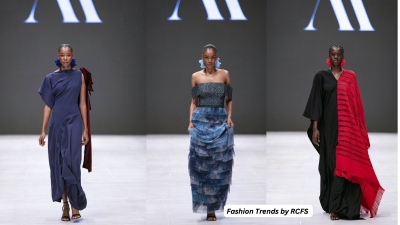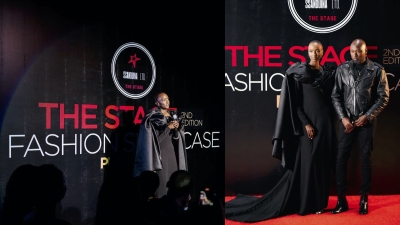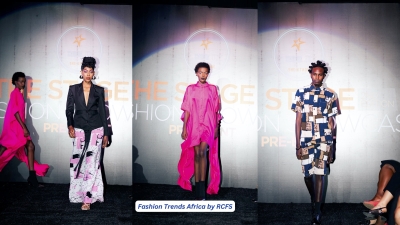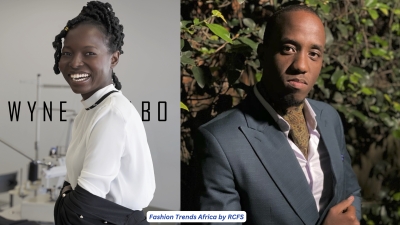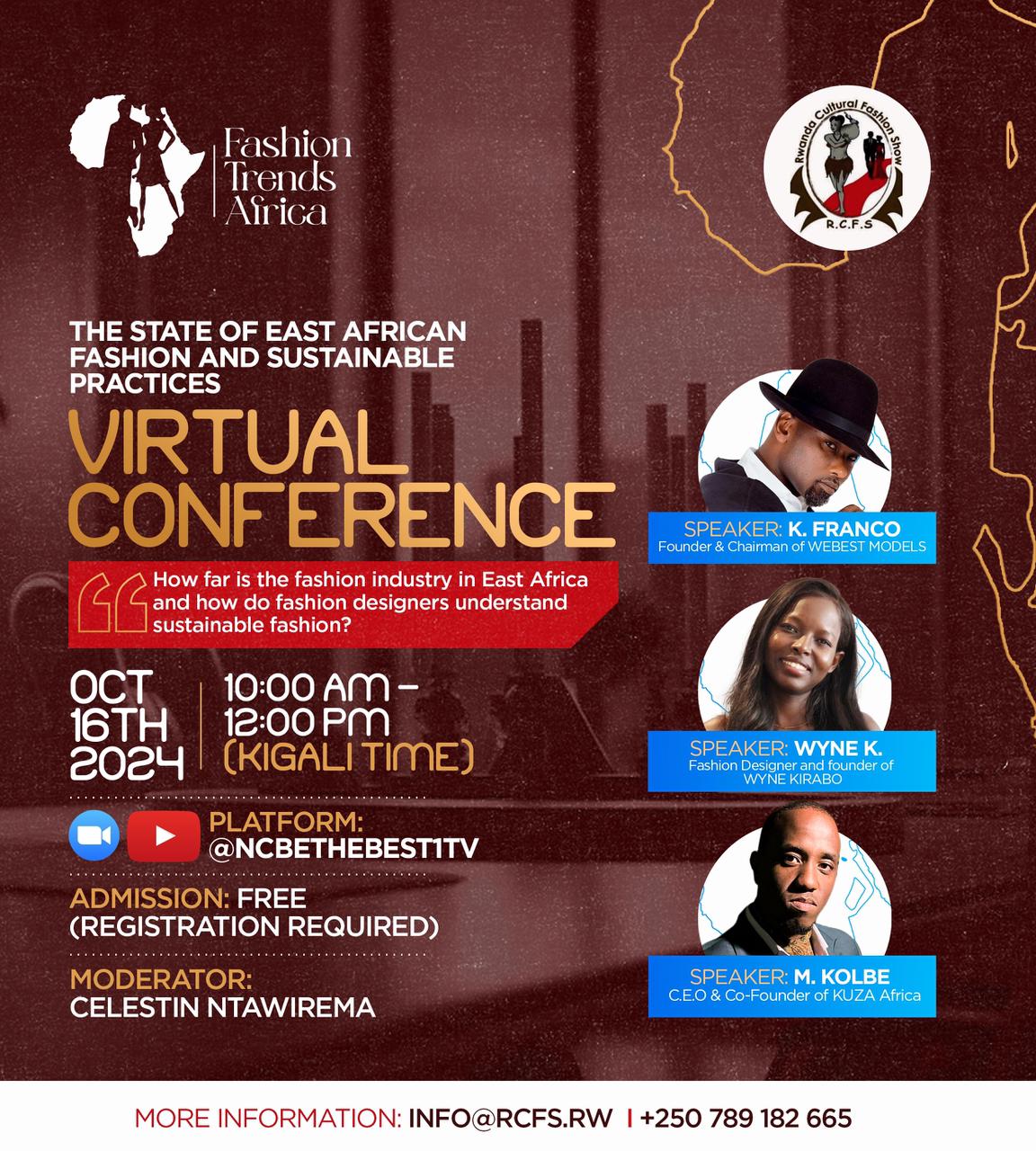![A woman sells fabrics at Kaporo market in Conakry, Guinea Monday, September 13, 2021 [Sunday Alamba/AP Photo]](/media/k2/items/cache/9962afd4d7801adbe96e49a2f2eab69f_L.jpg) A woman sells fabrics at Kaporo market in Conakry, Guinea Monday, September 13, 2021 [Sunday Alamba/AP Photo]
A woman sells fabrics at Kaporo market in Conakry, Guinea Monday, September 13, 2021 [Sunday Alamba/AP Photo]
Cheap China-made African print wax brands have been present in markets on the continent for decades, initially as badly-made replicas, but increasingly, as high-quality alternatives.
Accra, Ghana – On a weekday this December, the fabrics section at Accra’s frenzied Makola market was unusually quiet for the festive end-of-year period. Female traders with big woven hats sat in front of their stalls chatting and tiredly swatting away flies. Behind them, colourful African wax textiles were stacked in rows from ground to ceiling, waiting to be bought.
Vida Yeboah, one of the traders, said the stalls would normally be teeming with customers hunting for the latest designs to take to their tailors to cut up and sew into different styles from wide-mouthed A-Line dresses, to tops and skirts, for the New Year festivities. But Ghana’s shaky economy has forced many to shun that tradition.
“Since COVID, schools have started resuming in December and that means most people are thinking of how their sons and daughters would go to school,” the 55-year-old said. Schools are usually on holiday in December, but schedules for many schools changed after the long pandemic break. “Now, there is no money. People prefer to spend on other things, or they will go and buy the small ones.”
The ‘small’ brands Yeboah refers to are the much cheaper versions of African wax print that have flooded markets in Ghana and across Africa for years now, and that are giving “original” manufacturers tough competition. Imported from China, the fabrics often carry designs imitating more established brands and sell for between a third, to a tenth of the price. Some are outright counterfeits, claiming in typo-ridden labels to be recognisable brands.
But although these Chinese-made fabrics get a bad rap, some say they are increasingly of good quality, with their gaudy designs becoming more chic, and their colours no longer fading after a wash.
“Some people say it is good,” Yeboah said. “That original is too costly, even I myself, I don’t sell it,” she added, pointing to her stock. She sells Hitarget, a popular China-made brand seen as a high quality, cheaper alternative to big names, and that’s way ahead in the “smalls” range.
“This one is 90 cedis ($8), people can afford that one,” Yeboah said, picking up a blue and orange print with geometric designs. “If one doesn’t have the money for big ones, the person will at least buy something before leaving the market.”

A section of Ankara fabric at Makola market, Accra, Ghana [Shola Lawal/Al Jazeera]
Made in the Netherlands, loved in Africa
Known mostly as Ankara, the origins of the colourful fabric that has come to embody the very essence of African-ness on the continent, and for diasporans looking to stay connected to their roots, is not African itself.
The material was born when Dutch tradesmen in the 1800s attempted to mechanically mass-produce the intricate, hand-made designs of Javanese batik prints native to the Dutch East Indies, now Indonesia. The designs, made with a wax-resist dyeing method that left equal colour intensity on both sides of plain cotton spreads, didn’t catch on. But European printers soon found that their invention was getting unexpected attention somewhere else – in Africa.
Several Europeans including 22-year-old Pieter Fentener van Vlissingen, a Dutch manufacturer, started to produce the material in bales, cutting them up by the yard, and shipping them to bustling cities like Accra, where traders from other countries would travel to buy them. The myth goes that the name “Ankara” came from Hausa traders across West Africa attempting to call the fabric by where they bought it from – Accra.
In West and Central Africa, the boldly coloured cloth kickstarted a style revolution. People, especially women, wore the material everywhere – weddings, naming ceremonies, burials. Soon, the new fabric edged out indigenous materials like the earthy blue tye-dye Adire of the Yorubas in Nigeria and the flashy, hand-woven Kente of the Ashanti and Ewes of Ghana, which were heavier and not suitable for everyday wear like Ankara.
Vlissengen’s company was at the forefront of the new era.
“African women just embraced it,” Perry Oosting, the CEO of Vlissengen’s company, now called Vlisco, told Al Jazeera from the Helmond office. “They loved the brighter colors and they saw that the quality was better than what was available in the market compared to other imported goods, so that’s how it started. They embraced it and they also gave stories to it.”
After 177 years, the brand has gone on to become the most popular wax print maker on the continent, painting itself as the ‘original’ luxury brand, amid a sea of fake and counterfeit China-made copies. Six yards of Vlisco costs as high as 220 cedis ($200) but imitations cost much less. That though, Oosting said, could be to the brand’s advantage
“If you’re successful, you’re being copied, and it keeps us alert to continue to innovate and to be creative,” Oosting said. Vlisco, the CEO added, has no plans to lower prices, despite Ghana’s tight economy, soaring inflation in Nigeria, and the weakening of the Congolese Franc. Instead, it has invested in trademarking its designs using QR codes and has even trained customs officers in the Democratic Republic of Congo, a major market for the brand, to spot counterfeits.
“We’ve been through so much over the years, we’ve seen coup d’etats and actually, we have built some resilience,” Oosting said, adding that the pandemic, and the Ebola outbreaks that wracked the DRC were one of the brand’s toughest times. “What we are not doing is starting to discount because we have our product DNA that needs to be secured. Yes, the market is difficult but we want to keep our quality because we are not here for the next six months, we are here for the next decade, the next century.”
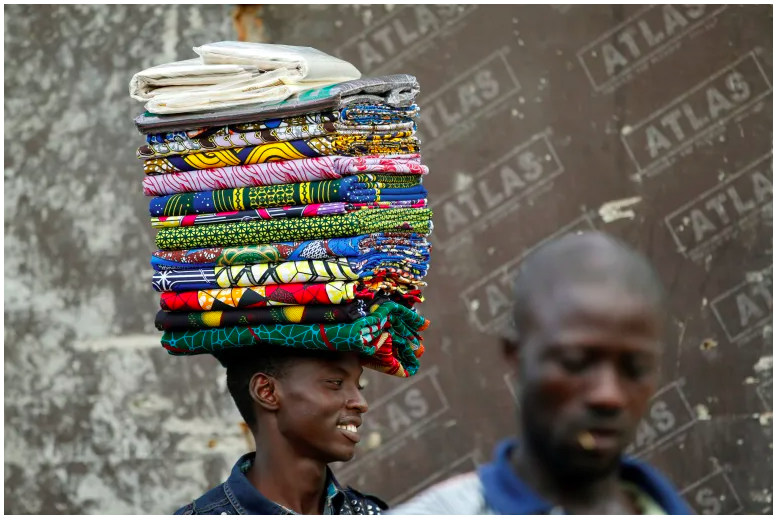
A man selling unsewn fabrics locally known as ‘Ankara’ walks through a street at Agege district in Lagos, Nigeria June 22, 2016 [Akintunde Akinleye/Reuters]
The Nana Benz era
In those early days of the African wax print, entrepreneurial African women worked with European manufacturers like Vlisco to come up with beautiful new patterns that also carried meaning and that the women bought exclusive distribution rights to.
In Togo, where the market had moved to because of Kwame Nkrumah’s protectionist policies in Ghana, the “Nana Benzes” became particularly skilled at monopolising prints. The group of several women traders were crucial to the success of Vlisco.
“We got so much feedback from the market through them,” Oosting of Vlisco said. “They were not just business partners, they were partners.”
Nana Benzes went on to be so successful between the 1960s – 1980s that they became some of the first female millionaires in Togo, the only ones able to afford luxurious Mercedes Benz cars, thus earning them their nicknames.
Now though, the Nana Benzes have been forgotten as Ankara production has moved to China.
So, too, have the local wax print brands that crept up in the mid-20th century – Africa’s independence era – in an attempt to localise the production of Ankara, to claim it fully as African and break the domination of European printers like Vlisco which still produces in the Netherlands.
In 1966, Ghana launched the Ghana Textiles Printing Company (GTP), with the government having majority stake. Around the same time, Akosombo Textiles Limited (ATL), particularly popular for its Adinkra symbols borrowed from the Gyamans ethnic group, also came on the scene. In Nigeria, the United Nigerian Textile Mills (UNTL) partnered with the Cha Group in Hong Kong to open a mill in northern Kaduna state. In Ivory Coast, Uniwax was birthed – a partnership between the Ivorian government and Unilever, the British consumer goods manufacturer.
But a cocktail of issues including government policies, counterfeits, a lack of infrastructure and the unavailability of locally sourced cotton, forced many printers to shutter or sell out, costing hundreds of textile workers their jobs.
GTP and Uniwax are now subsidiaries of Vlisco. Oostings of Vlisco says although its subsidiaries produce locally, Vlisco itself has no immediate plans to move manufacturing from Helmond to the continent.
Some brands are aiming to once again localise production but face similar issues.
Lome’s Wina Wax is designed locally but manufactured in China because of a lack of electricity, Marlene Adanlete-Djondo, the founder and a Nana Benz descendant, told Jeune Afrique. Producing in China is an attempt to adapt at all costs, while offering reasonable prices.
“Uniwax in Côte d’Ivoire and GTP in Ghana were bought by Vlisco certainly due to a lack of financial contributions,” Adanlete-Djondo said. “We do not want such a future for Wina Wax.”
Soft to the touch
As all sorts of smalls flood the market, it’s harder to distinguish between which is a good small or which is a bad small.
In Makola, young women arrange rolled-up “Smalls” on flat trays balanced on their heads and hawk them around. All the brands carry words like “Guaranteed” or “Real wax” on their edges.
But Augustina Otoo, a fashion designer in Accra said it’s the feel of the Ankara fabric, the flexibility of it, that often tells which ones are high quality and which ones are substandard, regardless of the name, brand or words printed on the cloth.
Most cheap imports use cheaper grades of cotton for production, and even mix the cotton with fabrics like polyester, whereas, authentic loinclothes are wholly cotton, Otoo, 26, added. Where quality Ankara fabric is soft to touch and yields under the heat of an iron, some smalls lack such mouldability, making them a pain to sew into the elaborate styles customers demand.
“Some of them are just like rubber, some of them even feel like paper,” Otoo said, laughing at her own analogy. “I’ve sewn a lot of them. When you’re ironing, it’s so stiff, it crumples. And when you want to straighten it, it just remains stiff. They put some shiny stuff on it that fades when you wash it. It doesn’t even last up to three months.”
But that hasn’t stopped her customers from buying them.
“This season especially, we’ve seen a lot of new designs in the small ones,” Otoo said. There’s little she can do to convince her customers to buy more authentic brands, she added. “Me, I just provide the service and collect my money.”
Latest from RCFS
- 9 Years Milestone: Moses Turahirwa and His Moshions Brand Rwanda-Based
- 9 Years Milestone: Moses Turahirwa and His Moshions Brand Rwanda-Based
- What to Expect in Lagos Heineken Fashion Week 2024: Runways Kick off Today
- What to Expect in Lagos Heineken Fashion Week 2024: Runways Kick off Today
- Storytelling Meets High Fashion at The Kenya Fashion Story 2024




